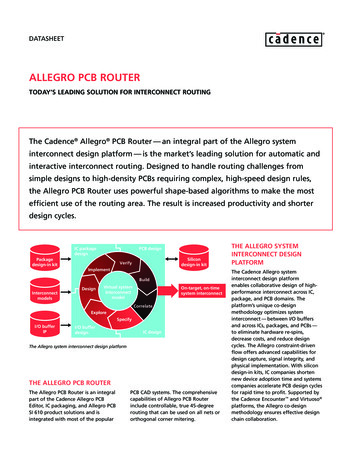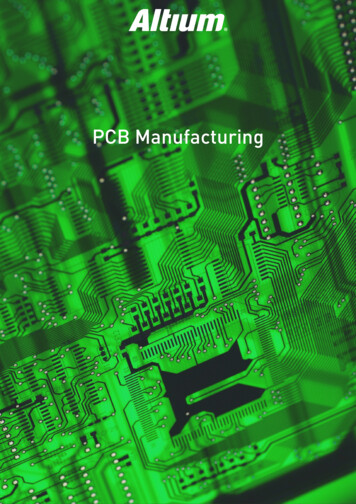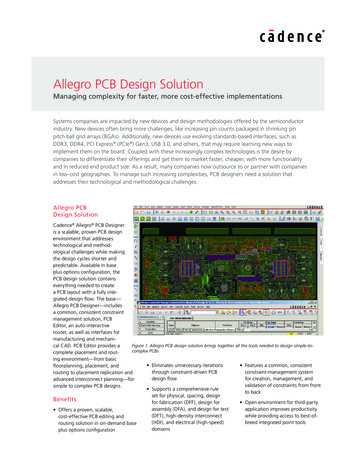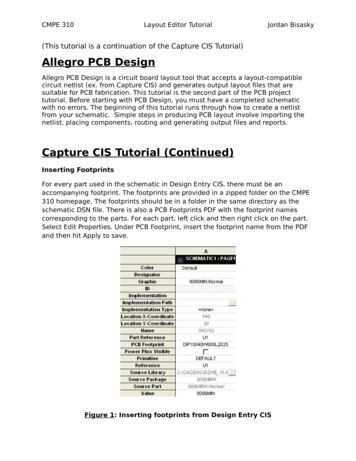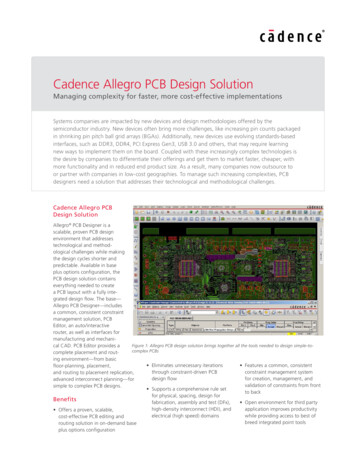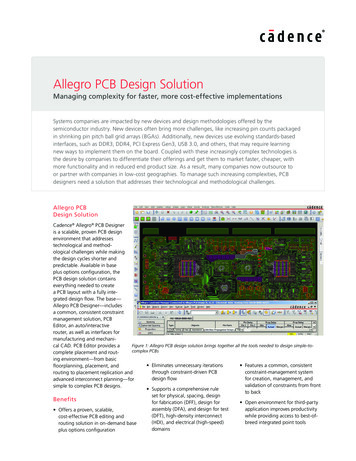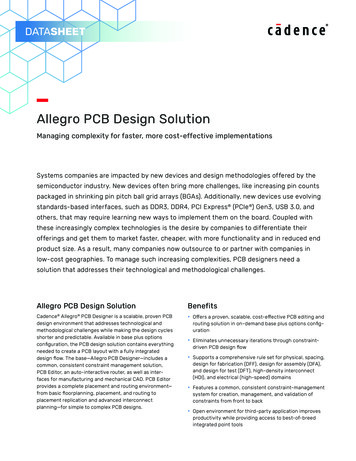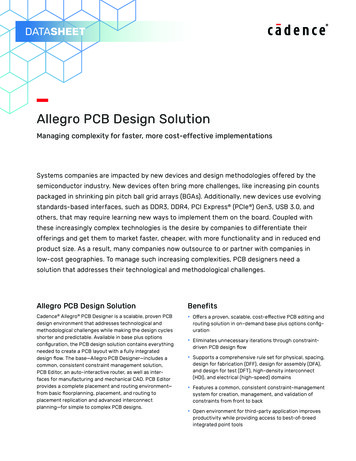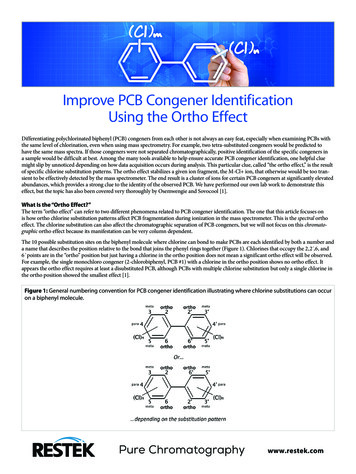
Transcription
Improve PCB Congener IdentificationUsing the Ortho EffectDifferentiating polychlorinated biphenyl (PCB) congeners from each other is not always an easy feat, especially when examining PCBs withthe same level of chlorination, even when using mass spectrometry. For example, two tetra-substituted congeners would be predicted tohave the same mass spectra. If those congeners were not separated chromatographically, positive identification of the specific congeners ina sample would be difficult at best. Among the many tools available to help ensure accurate PCB congener identification, one helpful cluemight slip by unnoticed depending on how data acquisition occurs during analysis. This particular clue, called “the ortho effect,” is the resultof specific chlorine substitution patterns. The ortho effect stabilizes a given ion fragment, the M-Cl ion, that otherwise would be too transient to be effectively detected by the mass spectrometer. The end result is a cluster of ions for certain PCB congeners at significantly elevatedabundances, which provides a strong clue to the identity of the observed PCB. We have performed our own lab work to demonstrate thiseffect, but the topic has also been covered very thoroughly by Osemwengie and Sovocool [1].What Is the “Ortho Effect?”The term “ortho effect” can refer to two different phenomena related to PCB congener identification. The one that this article focuses onis how ortho chlorine substitution patterns affect PCB fragmentation during ionization in the mass spectrometer. This is the spectral orthoeffect. The chlorine substitution can also affect the chromatographic separation of PCB congeners, but we will not focus on this chromatographic ortho effect because its manifestation can be very column dependent.The 10 possible substitution sites on the biphenyl molecule where chlorine can bond to make PCBs are each identified by both a number anda name that describes the position relative to the bond that joins the phenyl rings together (Figure 1). Chlorines that occupy the 2,2 ,6, and6 points are in the “ortho” position but just having a chlorine in the ortho position does not mean a significant ortho effect will be observed.For example, the single monochloro congener (2-chlorobiphenyl, PCB #1) with a chlorine in the ortho position shows no ortho effect. Itappears the ortho effect requires at least a disubstituted PCB, although PCBs with multiple chlorine substitution but only a single chlorine inthe ortho position showed the smallest effect [1].Figure 1: General numbering convention for PCB congener identification illustrating where chlorine substitutions can occuron a biphenyl molecule.www.restek.com
Experimentally, it has been shown that when a PCB congener has chlorine substitutions in the 2,2 - and 2,2 ,6- positions, the greatest effectis observed. The effect is less pronounced among the 2,6- and 2,2 ,6,6 - substituted congeners [1].As noted above, when chlorines are in these positions, a fragment ion formed by the loss of a single chlorine atom can be stabilized. Thegreater stability means that the ion fragment is more likely to exist long enough to be monitored by the mass spectrometer. In fact, astabilized M-Cl ion is sometimes present at 20-100% relative abundance compared to the base peak (i.e., the ion with the greatest abundance—often the molecular ion for PCBs). However, the telltale M-Cl ion for PCB congener identification will only be observed if a massspectrometer is monitoring the relevant masses.In our work, we found it possible to monitor the molecular ion as the precursor and the M-Cl as the product ion transition, as well as monitoring the M-Cl ion as the precursor and a subsequent M-2Cl ion as the product ion transition. Both were found to be viable, although thelatter showed higher abundances and was selected for the following example.An Illustration of the Spectral Ortho EffectTo illustrate the ortho effect, let’s examine six tetrachloro-substituted PCBs: PCB #s 44, 59, 42, 71, 41, and 72, which elute in that order froman Rtx-PCB column run under the conditions given in Figure 2. From their structures, shown in Figure 3, you would predict that three of thecompounds—PCB #s 44, 42, 41—would have pronounced ortho effects, exhibiting elevated M-Cl ion response compared to the other three.26.12 PCB-071Figure 2: Extracted ion chromatogram for a sequence of tetrachloro-substituted PCBs that should vary in degree of orthoeffect due to differences in chlorine substitution patterns. (Quantitation ion shown is from the M M-2Cl transition.)26.8027.0027.2027.40Time (min)GC EV1502ColumnSampleDiluent:InjectionInj. Vol.:Liner:Inj. Temp.:Purge Flow:OvenOven Temp.:Carrier GasFlow Rate:DetectorTransferLine Temp.:Analyzer Type:Source Type:Source Temp.:SolventDelay Time:Tune Type:Ionization Mode:Instrument2www.restek.comRtx-PCB, 60 m, 0.18 mm ID, 0.18 µm (cat.# 41304)AccuGrand 209 PCB standard (cat.# PCB-209-AG)Isooctane2 µL splitless (hold 0.75 min)Topaz 4.0 mm ID single taper inlet liner w/ wool (cat.# 23303)350 C100 mL/min120 C (hold 1.1 min) to 188 C at 20 C/min to 260 C at 2 C/min to300 C at 6 C/min to 320 C at 10 C/min (hold 6 min)He, constant flow1.44 mL/minTSQ 9000 with AEI320 CQuadrupoleAEI350 C11.01 minPFTBAEIThermo Scientific TSQ 8000 Triple Quadrupole GC-MS27.56
Figure 3: Of the six PCB congeners studied here, three have chlorines in the 2,2’-ortho positions (circled) and are predictedto exhibit a significant spectral ortho effect.All six PCBs are fairly well resolved from each other, so when all six are present they can provide reference points for one another, and it isnot too difficult to distinguish them, even without monitoring the telltale M-Cl ion. However, if a given sample had only a few of theseparticular PCBs present, some context is lost, and identification becomes more challenging. But, due to the ortho effect, confidence in a positive PCB congener identification can be increased by also using the M-Cl ion. As shown in Figure 4, the ortho effect leads to a stabilizedM-Cl ion that can then be monitored as the precursor ion in the MS/MS transition, showing a pronounced signal for that transition forthose PCBs that have chlorines in the 2,2 -spots.Figure 4: The stabilized M-Cl ion for PCBs exhibiting the ortho effect creates a strong signal for a M-Cl M-2Cl transition that provides valuable confirmation of PCBs 44, 42, and 41, which could be difficult to distinguish spectrally using theM M-2Cl transition alone.26.12 nInj. Vol.:Liner:Inj. Temp.:Purge Flow:OvenOven Temp.:PCB-041PCB-042PCB-044PCB-059PCB-071M M-2Cl Transition (m/z 289.9 220)M-Cl M-2Cl Transition (m/z 255 220)26.8027.00Time (min)27.20Carrier GasFlow Rate:DetectorTransferLine Temp.:Analyzer Type:Source Type:Source Temp.:SolventDelay Time:Tune Type:Ionization Mode:Instrument27.40Rtx-PCB, 60 m, 0.18 mm ID, 0.18 µm (cat.# 41304)AccuGrand 209 PCB standard (cat.# PCB-209-AG)Isooctane2 µL splitless (hold 0.75 min)Topaz 4.0 mm ID single taper inlet liner w/ wool (cat.# 23303)350 C100 mL/min120 C (hold 1.1 min) to 188 C at 20 C/min to 260 C at 2 C/min to300 C at 6 C/min to 320 C at 10 C/min (hold 6 min)He, constant flow1.44 mL/minTSQ 9000 with AEI320 CQuadrupoleAEI350 C11.01 minPFTBAEIThermo Scientific TSQ 8000 Triple Quadrupole GC-MS27.56GC EV1503www.restek.com3
PCBs that Exhibit Significant Spectral Ortho EffectsAs already noted, not all PCBs with chlorines substituted in ortho positions on the biphenyl rings will exhibit highly pronounced M-Cl stability. Predominately, congeners with the 2,2 - and the 2,2 ,6- positions substituted will have significant M-Cl signals. Out of the 209 totalPCB congeners, 84 congeners have ortho chlorines in the 2,2 - and 2,2 ,6- positions only (they may have chlorines in the meta and para positions as well, of course), so about 40% of the congeners would be expected to have M-Cl responses that range from close to 20-100% [1]of the intensity of the molecular ion. Keep in mind that while the effect will not likely be as pronounced, congeners with ortho chlorines inthe 2,6- and the 2,2 ,6,6 - substitution patterns (51 congeners in total) may still yield elevated M-Cl fragment responses compared to othercongeners that do not have pronounced ortho effects. This means that out of the 209 total PCBs, approximately 64% will display some degreeof ortho effect (Figure 5).Figure 5: Sixty-four percent of all 209 PCBs exhibit some degree of ortho effect.In summary, either directly monitoring the M-Cl ion or using it as a precursor ion in an MS/MS transition, as shown in this article, canprovide valuable insight into PCB congener identification. This powerful tool is available all because of the stabilization effect that chlorineatoms in certain positions on the PCB molecule can have.References1. Osemwengie, G.W. Sovocool, The mass spectrometric ortho effect studied for all 209 PCB congeners, International Journal of Mass Spectrometry, 352 (2013) k.com
Rtx-PCB Columns (fused silica)proprietary Crossbond phase Unique polymer for PCBs analysis by GC-ECD or GC-MS. Good results for other semivolatiles. Low polarity; inert to active compounds. Stable to 340 C.ID0.18 mm0.25 mm0.32 mmdf0.18 µm0.18 µm0.18 µm0.25 µm0.25 µm0.50 µmLength20 m40 m60 m30 m60 m30 mTemp. Limits30 to 320 C30 to 320/340 C30 to 320/340 C30 to 320/340 C30 to 320/340 C30 to 320/340 22613239Topaz GC Inlet LinersTopaz GC inlet liners feature revolutionary technology and inertness to deliver you thenext level of True Blue Performance: Deactivation—unbelievably low breakdown for accurate and precise low-level GCanalyses. Reproducibility—unbeatable manufacturing controls and QC testing for superiorreliability across compound classes. Productivity—unparalleled cleanliness for maximized GC uptime and lab throughput. 100% Satisfaction—if a liner doesn’t perform to your expectations, we will replace it orcredit your account.*PatentedTopaz 4.0 mm ID Single Taper Inlet Liner w/ Woolfor Agilent GCs equipped with split/splitless inletsID x OD x Length4.0 mm x 6.5 mm x78.5 mmPackingqtyQuartz Wool5-pk.Similar to Part #Agilent 5062-3587 (ea.), 5183-4693 (5-pk.), 5183-4694 (25-pk.), 51902293 (ea.), 5190-3163 (5-pk.), 5190-3167 (25-pk.), 5190-3171 (100-pk.)cat.#23303* 100% SATISFACTION GUARANTEE: If your Topaz inlet liner does not perform to your expectations for any reason, simply contactRestek Technical Service or your local Restek representative and provide a sample chromatogram showing the problem. If ourGC experts are not able to quickly and completely resolve the issue to your satisfaction, you will be given an account credit orreplacement product (same cat.#) along with instructions for returning any unopened product. (Do not return product prior toreceiving authorization.) For additional details about Restek’s return policy, visit www.restek.com/warrantyQuestions? Contact us or your local Restek representative (www.restek.com/contact-us).Restek patents and trademarks are the property of Restek Corporation. (See www.restek.com/Patents-Trademarks for full list.) Other trademarks in Restek literature or on itswebsite are the property of their respective owners. Restek registered trademarks are registered in the U.S. and may also be registered in other countries. To unsubscribe fromfuture Restek communications or to update your preferences, visit www.restek.com/subscribe To update your status with an authorized Restek distributor or instrumentchannel partner, please contact them directly. 2021 Restek Corporation. All rights reserved. Printed in the U.S.A.www.restek.comLit. Cat.# EVAR3726-UNV
Liner: Topaz 4.0 mm ID single taper inlet liner w/ wool (cat.# 23303) Inj. Temp.: 350 C Purge Flow: 100 mL/min Oven Oven Temp.: 120 C (hold 1.1 min) to 188 C at 20 C/min to 260 C at 2 C/min to 300 C at 6 C/min to 320 C at 10 C/min (hold 6 min) Carrier Gas He, constant flow Flow Rate: 1.44 mL/min Detector TSQ 9000 with AEI .

